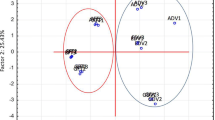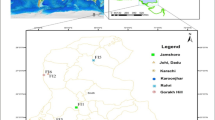Abstract
Adopting ICP-AES and ICP-MS to determine the content of 53 elements (6 macro-elements, 47 trace elements), which used HNO3 (5 mL) and H2O2 (2 mL) to digest Baishao (Paeoniae Radix Alba) by microwave. These herbs obtained from six producing areas in China, namely Xuanwu (Henan province), Shihezi (Xinjiang province), Zhongjiang (Sichuan province), Panan (Zhejiang province), Bozhou (Anhui province), and Heze (Shandong province). A certified reference material of Astragalus (GBW 10028, GSB-19) was used to assess the accuracy of the method. Except the slight change of Na and S in Xuanwu, the content of other producing areas followed the order of Ca > K > P > Mg > S > Na. The herbs of Shihezi (22,658 mg/kg) got the highest concentration of total elements, while the herbs of Panan (1.006 mg/kg) got the highest concentration of rare earth elements. The multi-element fingerprint map of Baishao was established, which was obviously different from other herbs. Meanwhile, the same method was adopted to determine the content of 50 elements in Baishao decoctions from three main producing areas. Compared with the herbs, each element was significantly reduced, and K was the highest concentration. The transfer rates of elements in Baishao decoctions followed the order (mean): As (55.79%) > Ni (55.19%) > Na (51.48%) > Mo (44.13%) > Ce (43.82%) > V (40.52%). The decoctions of Panan (0.122 mg/kg) got the highest content of rare earth elements. In all Baishao herbs and their corresponding decoctions, the levels of Cu, Cd, As, Pb, and Hg did not exceed the limits of the Green Trade Standards of Importing & Exporting Medicinal Plants & Preparations (WM2-2001) and Chinese Pharmacopoeia (2015).





Similar content being viewed by others
References
Zhang GY (2016) Chinese medicine commodity science. People's medical publishing house, Beijing
Rai V, Khatoon S, Bisht SS, Mehrotra S (2005) Effect of cadmium on growth, ultra-morphology of leaf and secondary metabolites of Phyllanthus amarus Schum. and Thonn. Chemosphere 61:1644–1650
Chinese Pharmacopeia Commission (2015) Pharmacopoeia of People's Republic of China. Chemical Medical Science Press, Beijing
Wu YS, Dong GZ (2000) Research progress of chromium nutrition. Chin J Anim Nutr 12(1):8–11
Jiang L (2001) Content and physiological function of selenium, chromium and lithium in tea. Southwest Hortic 29(2):45–46
Wang CY, Shi X (2012) Preliminary investigation on trace elements of zinc, manganese, copper and iron in 7 kinds of small grains in Yanchi county, Ningxia. China Brew 31(8):149–150
Tuo F, Li DH, Zhou FC, Luo JH, Tuo H, Kong XZ (2010) Determination of trace elements in Chinese medicinal plants by instrumental neutron activation analysis. J Radioanal Nucl Chem 284:507–511
Okatch H, Ngwenya B, Raletamo KM, Andrae-Marobela K (2012) Determination of potentially toxic heavy metals in traditionally used medicinal plants for HIV/AIDS opportunistic infections in Ngamiland District in Northern Botswana. Anal Chim Actaa 730:42–48
Bird SM, Ge H, Uden PC (1997) High-performance liquid chromatography of selenoamino acids andorgano selenium compounds. Speciation by inductively coupled plasma mass spectrometry. J Chromatogr A 789(1–2):349–359
Whanger PDJ (1998) Metabolism of selenium in humans. J Trace Elem Exp Med 11(2-3):227–240
Auyeung TW, Chang KK, To CH, Mak A, Szeto ML (2002) Three patients with lead poisoning following use of a Chinese herbal pill. Hong Kong Med J 8:60–62
Wu TN, Yang KC, Wang CM, Lai JS, Ko KN, Chang PY, Liou SH (1996) Lead poisoning caused by contaminated Cordyceps, a Chinese herbal medicine: two case reports. Sci Total Environ 182:193–195
Yang QW, Yang L, Xiong AZ, Wang R, Wang ZT (2011) Metabolomics study of anti-inflammatory action of Radix Paeoniae Rubra and RPA by ultra- performance liquid chromatography-mass spectrometry. China J Chin Materia Med 36:694–697
Huang H, Chen WW, Yu Y, Li ZY, Lin D, Huang RZ (2012) Raman spectroscopic analysis of Paeoniae Radix Alba decoction based on Raman technology. China J Chin Materia Med 37:3569–3572
Huang SJ, Wang R, Shi YH, Yang L, Wang ZY, Wang ZT (2012) Primary safety evaluation of sulfated Paeoniae Radix Alba. Acta Pharm Sin 47:486–491
Zhao XS, Wei JH, Shu XY, Kong W, Yang M (2016) Multi-elements determination in medical and edible Alpinia oxyphylla and Morinda officinalis and their decoctions by ICP-MS. Chemosphere 164:430–435
Wang ZZ, Wang HB, Wang HJ, Li Q, Li Y (2019) Heavy metal pollution and potential health risks of commercially available Chinese herbal medicines. Sci Total Environ 653:748–757
Markert B (1987) The pattern of distribution of lanthanide elements in soils and plants. Phytochemistry 26(12):3167–3170
Qi JS, Xu HB, Zhou JY et al (2000) Studies on the relation between amount of rare element and characteristics in Chinese medicinal herbs. Comput Appl Chem 17(2):181–182
Chen H (2002) Application and prospect of rare earth elements in Chinese herbal medicine. J Anal Sci 18(4):333–337
Guo BZ (1999) Application and research progress of rare earth in biological field. Chin Rare Earths 1:64–69
Zhou J, Guo LP, Xiao WJ, Geng Y, Wang X, Shi X, Dan S (2012) Plant physiological effects of rare earth elements and their application in Chinese herbal medicines. China J Chin Materia Med 37(15):2238–2241
Huang GX (2000) Bencao QiuZhen. (collation version). Shanghai science and technology press, Shanghai, p 34
Zhuang M, Wang L, Wu G, Wang K, Jiang X, Liu T, Xiao P, Yu L, Jiang Y, Song J, Zhang J, Zhou J, Zhao J, Chu Z (2017) Health risk assessment of rare earth elements in cereals from mining area in Shandong, China. Sci Rep 7(1):9772–9777
Sun J, Zhao H, Wang Y (1994) Study on the contents of trace rare earth elements and their distribution in wheat and rice samples by RNAA. J Radioanal Nucl Chem 179(2):377–383
Wen B, Yuan DA, Shan XQ, Li FL, Zhang SZ (2001) The influence of rare earth element fertilizer application on the distribution and bioaccumulation of rare earth elements in plants under field conditions. Chem Speciat Bioavailab 13(2):39–48
Zheng S, Zhang C, Shi K, Wang J, Sun G, Hu Q, Zhao F, Wang X (2018) Bioaccumulation, subcellular distribution and chemical forms of yttrium in rice seedling. J Rare Earths 36(3):331–336
Li XF, Chen ZB, Zhang YH et al (2013) Concentrations and health risk assessment of rare earth elements in soil and vegetables from a mining area in Fujian Province. Acta Sci Circumst 33(3):835–843
Song Y, Liu ZP, Jia XD (2013) A review on toxicology safety of rare earth elements. J Hygiene Res 42(5):885–892
Zhu WF, Xu SQ, Shao PP et al (1997) Study on biological effects of rare earth in southern Jiangxi province - daily allowance of rare earth. China Environ Sci 17(1):63–66
Hao LV, Zhang YL, Sun YJ, Duan YX et al (2019) Elemental characteristics of Sanqi (Panax notoginseng) in Yunnan province of China: multielement determination by ICP-AES and ICP-MS and statistical analysis. Microchem J 146:931–939
Hao LV, Zhang YL, Sun YJ, Duan YX (2019) Multielement patterns of Danshen (Salvia miltiorrhiza) from origins in China. Microchem J 145:273–279
Halkidi M, Batistakis Y, Vazirgiannis M (2001) On clustering validation techniques. J Intell Inf Syst 17(2–3):107–145
Zha LP, Yang J, Peng HS, Hu HB (2011) Germplasm investigation of Radix paeoniae alba from four major producing areas. J Chin Med Mater 34(7):1037–1040
Khuder A, Sawan MK, Karjou J, Razouk AK (2009) Determination of trace elements in Syrian medicinal plants and their infusions by energy dispersive X-ray fluorescence and total reflection X-ray fluorescence spectrometry. Spectrochim Acta B 64:721–725
Funding
This work was finically supported by National Key R&D Program of China (2018YFC1707004) and the Key project of Anhui University of Traditional Chinese Medicine (2018zrzd07).
Author information
Authors and Affiliations
Corresponding author
Ethics declarations
Conflict of Interest
The authors declare that they have no conflict of interest.
Additional information
Publisher’s Note
Springer Nature remains neutral with regard to jurisdictional claims in published maps and institutional affiliations.
Electronic supplementary material
ESM 1
(PDF 416 kb)
Rights and permissions
About this article
Cite this article
Xue, X., Liu, G., Wei, Y. et al. Multi-element Characteristics of Chinese Medical Baishao (Paeoniae Radix Alba) and Their Decoctions. Biol Trace Elem Res 199, 2375–2386 (2021). https://doi.org/10.1007/s12011-020-02343-0
Received:
Accepted:
Published:
Issue Date:
DOI: https://doi.org/10.1007/s12011-020-02343-0




